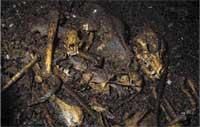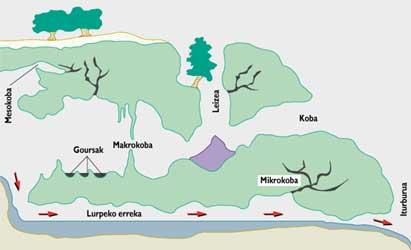Rock fauna
The man of Magdalenian drew numerous bison, horses and other animals, among which was drawn the first cave insect known in the cave of Groutte de Tràs-Frenes (Pyrenees of Arieg), in a bison bone. In addition, thanks to the precision of the drawing, L. The entomologist Chopard, no doubt, could indicate that it was of the genus Troglophilus.

Today we know that in the caves inhabits a very diverse fauna, composed mainly of invertebrates. This fauna is organized within an ecosystem very different from the outside.
The most specialized, which only live in the caves, are the troglobs, but also those that have different degrees of adaptation to the hypogeoid environment. The most important part of the life cycle are the troglophils that inhabit other means than those exposed there, and those that penetrate the caves short or by chance, are the trogloxenes.
The hypogeal ecosystem and the influence of local factors on the nursery
The underground medium and its living beings constitute a very special ecological unit. Abiatic and trophic factors are involved in the hypogean ecosystem, although they are not exclusive features for this individually considered ecosystem.
On the other hand, the distribution between surface areas and caverns is gradual. The intermediate zones and the inhabitants of the place also have intermediate characteristics. In addition, these spaces are of special importance to understand the colonization of underground media and maintain the trophic conditions of the hypogeal ecosystem.
As for the size of the caves, these can be divided into three: macrocovalas (more than 20 cm), mesoconas (0.1 to 20 cm) and microcovalas (less than 0.1 cm). In the first one large vertebrates can be introduced, the second one is suitable for cave arthropods and the third one is too small for them. Most cabernícolas live in macros and mesocoveas, devoting most of the time to the mesocobeo. Ugal and larval forms use microcovals and sediments.
The hypogeum is formed by land and water fields. On the ground you can distinguish galleries (including mesococas), network of interstices and sediments within the galleries. In water, sersos, lakes and underground streams (see figure above).

The succession of holes in the karst makes it difficult to separate the different zones. Except in the entrance area of the caves, photosynthesis is not carried out inside them, so strict phytophagi cannot reside in them and, in addition, multicellular animals must obtain from another the necessary vitamins, growth factors and trace elements.
Another characteristic of the caves is its high relative humidity, which often has values between 95% and 100%. In our observations we have not reached these values, for which deeper caves and development are required. But what really affects cabernícolas is dehydration. The decrease in humidity in small amounts causes death, since most of the cabernícolas are hygrophiles or stenohygrobes, so they require high atmospheric humidity. Cavernicola lacks a protective pigmented layer or is very degenerate, so its teguments are very permeable to water.
In this respect, many cabernícolas can be considered as amphibians. Terrestrial arthropods are abundant and some isotopes, diplopods and rabbits can enter and live for a time in the water. Thus, many land nurseries are able to suffer occasional flooding. On the contrary, many aquatic cavemen are able to live on earth and thus can move from one gours to another due to high atmospheric humidity.
Due to the high humidity requirements, in general, there will be no cabernícolas in galleries with large drafts.
On the other hand, the hypogeal medium is very stable. This stability manifests itself in total darkness, high humidity and temperature.
The air temperature in the caves is reduced throughout the year (between 0.5 and 2 ° C) and is similar to the average municipality where it is located (Baltzola cave: 13.1°C; Auza-Gaztelu Cave: 12.6°C). The water of the caves, on the other hand, is one or two degrees less than the air. In high caves, due to snow, water and air can be colder. However, in general, air temperature is usually very stable.
The stability of the conditions eliminates the main rhythms of life. For example, it generates inactivity of photoperides. Lack of seasons eliminates the annual reproductive cycle and high lethards (hibernation and stowage). However, there are cycles that are not so visible. In spring, when the melting of snow occurs and therefore increasing the flow of underground streams, the conditions are more humid in the caves and the proliferation of araneidos, Niphargus or Proteus will be launched. In amphibians and copepods, for their part, lethargy periods have been observed to cope with the possible drying of gours and wells in summer.
It should be noted that most animals that inhabit the caves, leaving aside streams of the stream, live in ponds, gours or ponds.
Possible disturbances are more visible at the entrances of caves, springs and large air galleries. In these places, by chance or regularly may appear a trogloxene fauna, but the coercive cabernícolas will tend inward in search of a more stable situation.

Trophic factors in the hypogee ecosystem
Except in the surroundings of the entrances, in the caves, the darkness is total and therefore missing photosynthesizers. Consequently, the only food inlet inside the cave is that brought by the outer waters or animals that penetrate it, as well as their excrements and their bodies.
Although some tropical karst are eutrophic (nutrient-rich), in general the caves are oligotrophic (non-food). Adapted nurseries have had to develop a polyphagy capacity and a low metabolic rate to compensate for lack of food. The increase in the presence of food at any given time affects the rhythms of the cabernícolas, but the presence or absence of exogenous foods mainly affects the distribution and quantity of the cabernícolas.
In the absence of light, primary production is limited to the chemosynthesis of autotrophic bacteria. They live in clay and silt, transforming the chemical elements that would be lost into new organic matter. They are able to synthesize vitamins and trace elements, so they occupy an important place in the hypogeum medium. Sometimes heterotrophic exogenous bacteria can appear from the outside if there is organic matter.
Another source of food is the organic matter that provides the water that comes by filtration.

The organic matter provided by bacteria and water are foods of the Protozoa group (unicellular creatures). These and the plankton that brings the water of the middle epigee are the basic food of the rest of the cabernícolas, that is, of the protozoo and the microfauna (see table page 42). Above them would be the macrofauna. Silts and clays are often consumed to prevent abitaminosis. However, the trophic relationships between macrofauna are quite complicated, since all of them can be considered omnivorous. Between these two large groups are the boroughs, microphones and detractors.
However, the main source of food is the epigeal medium, both through water, through leaves, branches and fallen organic matter, as well as the excrements and bodies of troglophils and trogloxenes.
Adaptations for hypogeal life

Troglobio fauna presents some changes in their behavior, physiology and anatomy. The most significant and widespread changes are four: loss of pigmentation; atrophy of structures related to vision (therefore loss of vision); thinning of appendages by hypertrophy of non-optical sensory structures; and low metabolic rate. But there are others of different level:
- Anophthalmos. The lack of functionality of the eyes between the troglobes is widespread, from a marked atrophy of the eyes to the complete disappearance of the optic nerves and the optical centers of the brain. Many groups may change, but in general the atrophy extends from the periphery to the central structure.
- Depigmentation. The formation of pigments is biochemically controlled by enzymes and hormones, so the lack of light will cause the absence of synthesis. Depigmentation is irreversible (it is genetically controlled) and in the troglophils, in general, reversible, that is, light would cause a synthesis.
- In cavernicola, in almost all groups, the metabolism is quite lower than in epigees of the same group. This means lower oxygen consumption and reduced activity. In this way, troglobes have longer rest periods, move less to find food, have a more relaxed breathing and have a slower reaction to escape predators. However, by touching or clarifying it, they quickly escape.
- Gigantism. Troglobes are generally larger than epigees in the same group. Exceptionally there are forms derived from interstitial fauna, being less than usual. It is logical to think that these two tendencies, among other causes, can also occur by the so-called island effect, since, in short, the caves are very isolated means (hence they have many edesame).
- Gigantism influences other characteristics. Most troglobes usually lay less eggs but larger. All subsequent processes are slower, with a smaller larval phase and longer life span. Neotenic examples (Proteus anguinus ..) are also abundant.
 Elona quimperiana. Cantabrian endemism frequent in cave meadows.
Elona quimperiana. Cantabrian endemism frequent in cave meadows. - They usually have slender bodies and longer appendages than the epigees of the same group. This can be seen especially in the coleoptera Trechinae, Opiliones, Pseudoescorpiones, Crustaceans, Orthoptera and Trechinae. This is accompanied by the proliferation and development of sensory organs (mainly chemoreceptors and tactile), favoring the search for food and facilitating intra-specific chemical communication.
- Among the insects have been mentioned fisogastria (excess fat in insects and excessive thickening of the abdomen) and apterism. A frequent correlation between insects between depigmentations, anapthalmias and apterisms is observed, which is explained by attributing the control of these three characters to the same group of genes.
- Changes also occur in the internal anatomy of the troglobes. For example: simplification of the digestive tract; decreased gonad; decreased ovary and asymmetric; decreased activity of the endocrine glands; decreased brain optic centers, optical lobes and optic nerves.
- Behavior. Most of them have been mentioned above: absence of daily and annual rhythms, slowness, negative phototropism or lack of reaction to light, aquatic cabernícola rheophobia, negative reaction to the lack of humidity of the air stream and atmosphere, slow search for food, absence of escape reaction, omniborism, geography and special habits of reproduction. However, there are many reactions with other external factors, such as being very sensitive to contact, vibrations, temperature and humidity changes, etc. In general, it seems that the receptor stimuli are found in the antennas, and that they are also able to detect the presence distantly.
 In the entrances of the caves it is frequent to find tisoneros. These require high humidity and are nocturnal.
In the entrances of the caves it is frequent to find tisoneros. These require high humidity and are nocturnal.
Main underground biotopes, biocenocytes and cave groups
Biocenosis is a community that lives in a specific environment, in our case in the caves. Each biocenosis is composed of populations and each of them lives in a certain biotope.
In the karst caves of our environment, five main biotopes, each with its population:
- Walls and ceilings near the entrance, with local parietal association.
- Entrances and demolition cones with endogenous fauna.
- Deep zone and native aquatic fauna.
- Excrements and native fauna.
- Gours, lakes, underground stream and aquatic cave fauna.
These biotopes have no specific limitations and can be divided into subunits. Finally, it should be mentioned that the caves are a very isolated environment, on the one hand, with few predators and on the other, with numerous endemism. As a result of the latter, along with tropical forests, caves are the ecosystems that most new species “give”.






